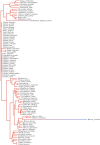Postcopulatory sexual selection influences baculum evolution in primates and carnivores
- PMID: 27974519
- PMCID: PMC5204150
- DOI: 10.1098/rspb.2016.1736
Postcopulatory sexual selection influences baculum evolution in primates and carnivores
Abstract
The extreme morphological variability of the baculum across mammals is thought to be the result of sexual selection (particularly, high levels of postcopulatory selection). However, the evolutionary trajectory of the mammalian baculum is little studied and evidence for the adaptive function of the baculum has so far been elusive. Here, we use Markov chain Monte Carlo methods implemented in a Bayesian phylogenetic framework to reconstruct baculum evolution across the mammalian class and investigate the rate of baculum length evolution within the primate order. We then test the effects of testes mass (postcopulatory sexual selection), polygamy, seasonal breeding and intromission duration on the baculum in primates and carnivores. The ancestral mammal did not have a baculum, but both ancestral primates and carnivores did. No relationship was found between testes mass and baculum length in either primates or carnivores. Intromission duration correlated with baculum presence over the course of primate evolution, and prolonged intromission predicts significantly longer bacula in extant primates and carnivores. Both polygamous and seasonal breeding systems predict significantly longer bacula in primates. These results suggest the baculum plays an important role in facilitating reproductive strategies in populations with high levels of postcopulatory sexual selection.
Keywords: Bayesian phylogenetics; baculum; carnivores; postcopulatory sexual selection; primates; prolonged intromission.
© 2016 The Authors.
Figures


References
-
- Perrin WF, Wursig B, Thewissen JGM (eds). 2009. Encyclopaedia of marine mammals, 2nd edn London, UK: Academic Press.
-
- Weimann B, Edwards MA, Jass CN. 2014. Identification of the baculum in American pika (Ochotona princeps: Lagomorpha) from southwestern Alberta, Canada. J. Mammal. 95, 284–289. (10.1644/13-MAMM-A-165) - DOI
MeSH terms
Associated data
LinkOut - more resources
Full Text Sources
Other Literature Sources

